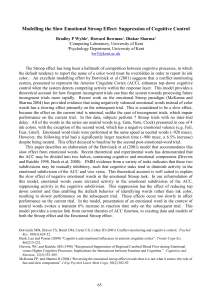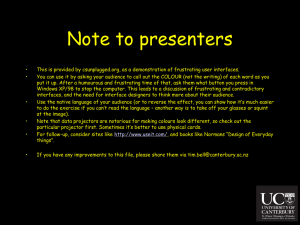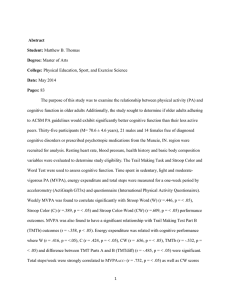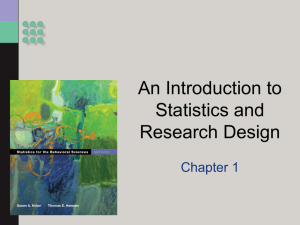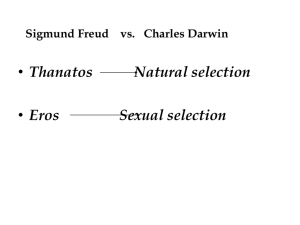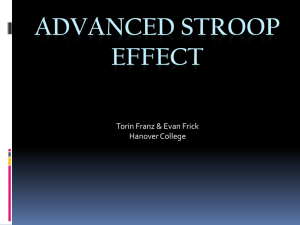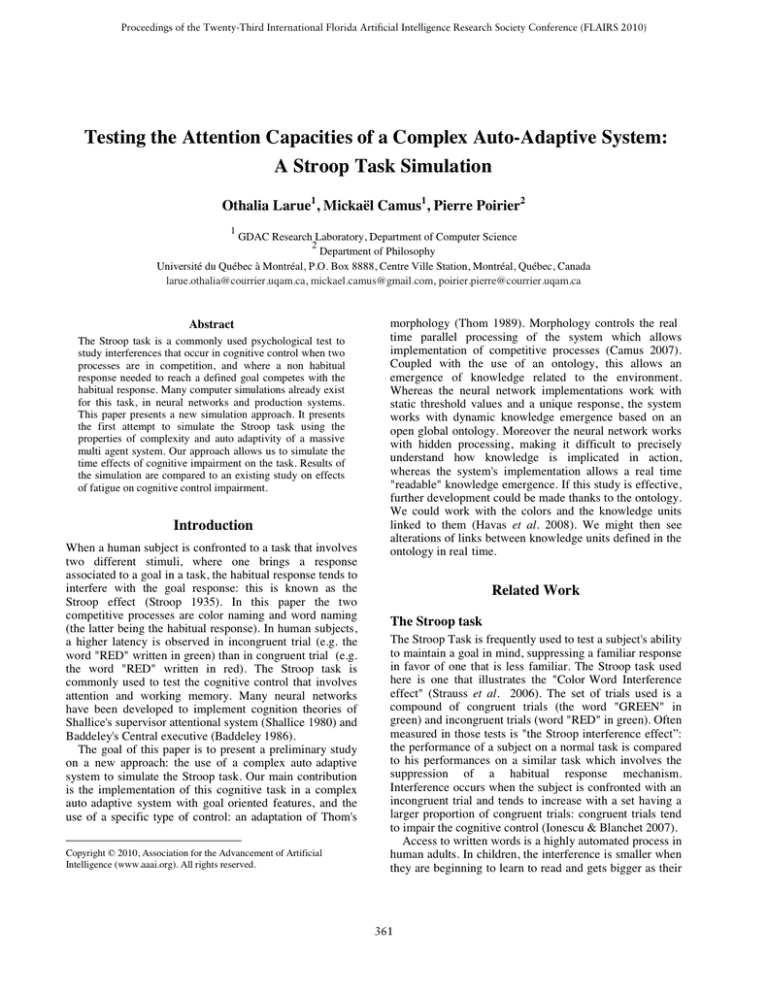
Proceedings of the Twenty-Third International Florida Artificial Intelligence Research Society Conference (FLAIRS 2010)
Testing the Attention Capacities of a Complex Auto-Adaptive System:
A Stroop Task Simulation
Othalia Larue1, Mickaël Camus1, Pierre Poirier2
1
GDAC Research Laboratory, Department of Computer Science
2
Department of Philosophy
Université du Québec à Montréal, P.O. Box 8888, Centre Ville Station, Montréal, Québec, Canada
larue.othalia@courrier.uqam.ca, mickael.camus@gmail.com, poirier.pierre@courrier.uqam.ca
Abstract
The Stroop task is a commonly used psychological test to
study interferences that occur in cognitive control when two
processes are in competition, and where a non habitual
response needed to reach a defined goal competes with the
habitual response. Many computer simulations already exist
for this task, in neural networks and production systems.
This paper presents a new simulation approach. It presents
the first attempt to simulate the Stroop task using the
properties of complexity and auto adaptivity of a massive
multi agent system. Our approach allows us to simulate the
time effects of cognitive impairment on the task. Results of
the simulation are compared to an existing study on effects
of fatigue on cognitive control impairment.
Introduction
When a human subject is confronted to a task that involves
two different stimuli, where one brings a response
associated to a goal in a task, the habitual response tends to
interfere with the goal response: this is known as the
Stroop effect (Stroop 1935). In this paper the two
competitive processes are color naming and word naming
(the latter being the habitual response). In human subjects,
a higher latency is observed in incongruent trial (e.g. the
word "RED" written in green) than in congruent trial (e.g.
the word "RED" written in red). The Stroop task is
commonly used to test the cognitive control that involves
attention and working memory. Many neural networks
have been developed to implement cognition theories of
Shallice's supervisor attentional system (Shallice 1980) and
Baddeley's Central executive (Baddeley 1986).
The goal of this paper is to present a preliminary study
on a new approach: the use of a complex auto adaptive
system to simulate the Stroop task. Our main contribution
is the implementation of this cognitive task in a complex
auto adaptive system with goal oriented features, and the
use of a specific type of control: an adaptation of Thom's
Copyright © 2010, Association for the Advancement of Artificial
Intelligence (www.aaai.org). All rights reserved.
morphology (Thom 1989). Morphology controls the real
time parallel processing of the system which allows
implementation of competitive processes (Camus 2007).
Coupled with the use of an ontology, this allows an
emergence of knowledge related to the environment.
Whereas the neural network implementations work with
static threshold values and a unique response, the system
works with dynamic knowledge emergence based on an
open global ontology. Moreover the neural network works
with hidden processing, making it difficult to precisely
understand how knowledge is implicated in action,
whereas the system's implementation allows a real time
"readable" knowledge emergence. If this study is effective,
further development could be made thanks to the ontology.
We could work with the colors and the knowledge units
linked to them (Havas et al. 2008). We might then see
alterations of links between knowledge units defined in the
ontology in real time.
Related Work
The Stroop task
The Stroop Task is frequently used to test a subject's ability
to maintain a goal in mind, suppressing a familiar response
in favor of one that is less familiar. The Stroop task used
here is one that illustrates the "Color Word Interference
effect" (Strauss et al. 2006). The set of trials used is a
compound of congruent trials (the word "GREEN" in
green) and incongruent trials (word "RED" in green). Often
measured in those tests is "the Stroop interference effect”:
the performance of a subject on a normal task is compared
to his performances on a similar task which involves the
suppression of a habitual response mechanism.
Interference occurs when the subject is confronted with an
incongruent trial and tends to increase with a set having a
larger proportion of congruent trials: congruent trials tend
to impair the cognitive control (Ionescu & Blanchet 2007).
Access to written words is a highly automated process in
human adults. In children, the interference is smaller when
they are beginning to learn to read and gets bigger as their
361
reading ability increases (Strauss et al. 2006). In adults,
interference comes from the need to override competing
pathways at the stage of the response selection: the ability
to respond to a stimulus when a more compelling one (the
written word) is available. The roles of selective attention
and context processing are fundamental for this task. The
task instruction emphasizes the context which will lead the
subject to produce the right answer (Ionescu & Blanchet
2007). It has also been shown that working memory
capacity plays an important role on performance in the
Stroop task. The failure to maintain the goal may not be the
only phenomena involved. The time consuming process
that selects among the competitive responses to one that is
appropriate to the goal at hand seems to have its
importance too. Stroop interference may then be
decomposed into attentional and memorial components
(Engle et al. 2003).
Research that has focused on identification of the
supposed components of executive processes and their
neural substrates has revealed a new model of what may be
going on (Botvinick et al. 2001). This model consists of a
response conflict monitoring system, executed in the
anterior cingulate cortex (ACC) and the cognitive control
system located in the dorsolateral prefrontal cortices
(DLPFC). The response conflict monitoring parses
information from the system looking for response conflicts
due to interference between processes. The cognitive
control system modifies information processing in the
posterior brain regions in order to reduce those conflicts
(Schmidt et al. 2009).
Computer simulations
Several simulations of this specific task have been realized
over the years, using neural networks and production
systems.
In all neural network simulations stronger connections
are made in the "word to name" pathway than in the "color
to name" pathway. A fixed threshold indicates that the trial
is terminated. The number of cycles needed to reach
threshold is generally considered as an equivalent of the
reaction time of human subjects (Servan Schreiber et al.
1998)
Dehaene's neural network (Dehaene et al. 1998)
illustrates the hypothesis of two computational spaces,
where the processes underlying effortful tasks take place:
the Global Workspace and a space composed of a set of
specialized perceptual and motor neurons.
In Gilbert and Shallice's model (Gibert & Shallice 2002)
built around the notion of supervisor of attentional system
(SAS) (Norman et al. 1980), the SAS has access to a
representation of the environment and of the organism’s
intention and cognitive disorders. The ‘‘task demand’’
units regulate the activation to their corresponding
pathways (color naming and word reading) assuming the
regulation role of an SAS. More recent work (Buyukaksoy
et al. 2007), makes a component of the neural network
correspond to a particular neuroanatomic component of the
prefrontal circuit taking part in the execution of the Stroop
task. Also built with the notion of an SAS named "the
attention directing module," this module and a habitual
response module are in turn inhibited depending on the
task. The response time is the same as for human subjects,
thanks to a specific use of processor properties in the
implementation of the network. An analogy can be made
between the architecture of the above simulations and ours:
a control unit and specialized units processing the inputs.
The ACT R cognitive architecture (Anderson & Lebiere
1998) is often used for cognitive simulations with
production rules. “NJAMOS” (Lovett 2002) is one of them
using parallel processing. A set of production rules
specifies the knowledge required to perform a Stroop task.
Fixed mechanisms in ACT R help the system choose
production rules during the goal retrieving process. The
simulation presented in this paper is a whole different
approach. Parallel processing is used to perform the
internal organization of the system. The internal
organization performs the goal directed behavior of the
system.
Method
Complex Auto-Adaptive System
The system used in the paper is a Complex Auto Adaptive
System (AAS) (Camus 2007). In the AAS, the decision
making level proceeds with parallel information, real time
processing and communication. The properties of the
system are compatible with the notion of consciousness as
defined here (Changeux 1985 p158):
The different groups of neurons in the reticular
formation inform each other of their mutual activity.
They form a system of hierarchical, parallel pathways
in permanent reciprocal contact with the other
structures of the brain. A holistic integration between
various centers results. From the interplay of these
linked regulatory systems, consciousness is born.
Here are the main defining properties of the system:
morphology, auto adaptivity, complexity which are
interrelated.
Morphology. In the AAS, it is morphological organization
that allows the control of the system: Thom's morphology
has been applied to a multi agent system in a synchronous
adaptation (Campagne 2005), whereas in the present AAS
adaptation is asynchronous adaptation in a massive multi
agent system (Camus 2008). In Thom's morphology,
geometric shapes represent information and phenomenon
(Thom 1989 p7):
The space of observables M contains a closed subsets
K called the catastrophe set, and as long as the
representative point m of the system does not meet K,
the local nature of the system does not change
[…].The evolution of the system will be defined by a
vector field X on M, which will define the
macroscopic dynamic. Whenever the point m meets
K, there will be a discontinuity in the nature of the
362
system which we will interpret as a change in the
previous form, a morphogenesis […]. From a
macroscopic examination of the morphogenesis of a
process and a local and global study of its
singularities, we can try to reconstruct the dynamic
that generates it.
In AAS, morphology is the geometrical shape taken by an
organization of agents. Depending on the situation, the
morphology will increase or decrease the prominence of
agents. The agents in charge of morphology compute
statistics regarding the activity of structuring agents. There
is constant communication between the morphological
agents and the structuring agents (see below).
Morphology’s goal in the system is to turn the system
towards a specific shape in order to match its goals.
Auto-adaptativity and complexity. The system is built
around a systemic loop (defined below). Parallel
processing allows the system to adapt its behavior to its
environmental situation, repeating the same steps in cycle.
This behavior is possible because of a large number of
low level agents acting as in Holland's definition of a
Complex Adaptive System (Waldrop 1993 p194):
A Complex Adaptive System (CAS) is a dynamic
network of many agents […] acting in parallel,
constantly acting and reacting to what the other agents
are doing. The control of a CAS tends to be highly
dispersed and decentralized. If there is to be any
coherent behavior in the system, it has to arise from
competition and cooperation among the agents
themselves. The overall behavior of the system is the
result of a huge number of decisions made every
moment by many individual agents.
AAS is complex because of its auto adaptive organization
(Pinker 2000 p160):
Organisms are not just cohesive blobs […]. They are
machines, and their "complexity" is functional
adaptive design: complexity in the service of
accomplishing some interesting outcome.
Components of the system
The Ontology. Describing the knowledge level (Newell
1982), the ontology contains the knowledge that is
translated into agents in the system. The ontology is
distributed: the knowledge is a group of words which are
linked, the links between the words help define their
topography in the morphologic organization. Knowledge is
shared and interpreted at the same time in numerous
agents. Each stimulus is understood thanks to the
knowledge. There are knowledge units representing
"physical capacities," which are linked to other units. The
words classification forms various conceptual plans. For
the purpose of this paper, we only used the "Object"
conceptual plan. When aggregated to a robot, the system is
able to send robot commands based on the decision the
system takes. Decisions made are based on the system's
representation of its environment.
Links. The ontology also contains the links between the
knowledge units. New links can be created during
experiments and the system can thus capture an amount of
new information. In this paper, we established links
between the knowledge units representing the colors, and
with the frontal agents first described in (Havas et al.
2008): the agents (see below) in charge of processing
information from environmental stimuli.
The agents. Each agent has a communication module, a
role and a state (defined by a level of activation).
Depending on its role, it will be associated to a specific
organization. The system's basic agent is the aspectual
agent (Cardon 2005). All agents have the same structure as
that of the aspectual agents. Every aspectual agent has
communications channel to others, and the ability to create
new agents and is able to structure the system using his
communication feature. Agents differ by their implication
in a specific organization depending on their role:
• Structuring: Representing the knowledge inserted in the
ontology, they produce the internal activity of the system.
Their state depends on the information sent by the inputs
and the links of the agent in the ontology.
• Morphological: Morphological representation depends on
the organization of the structuring agents. Observation of
the structuring agents will lead to assignment of a
geometrical shape, which then enables the interpretation.
• Analyze: Geometrical shapes are generated thanks to the
morphology. These shapes are interpreted as graph of
histograms which are used by the Pattern of specific events
agents.
• Pattern of specific events (PSE): These are aspectual
agents using the graph sent by the "analyze" agents. Their
role is set to "goal". The goal is sent by the user. In the
present paper, the goal is "RecognizeColor". When the
system is working, a shape is associated to
"RecognizeColor". When "RecognizeColor" is activated,
the knowledge units to which it is linked are activated too,
causing this shape to incorporate their topology. This is
then this shape the system will try to conform to, in order
to reach a goal. The distance between the targeted shape
and current shape is used to control activations in order to
reach the targeted shape. It focuses the system on specific
elements and enables them to act according to its current
objectives, and is therefore part of the decision making
process. The PSE is a kind of “limited” capacity (imposed
by the system) attention administrator, controlling
activities in the system. In this sense, it is similar to a
Central Executive (evolution of Shallice's notion of SAS),
in Baddeley's working memory model which posits a
limited control role of the working memory on cognitive
activities. The PSE will allow the activation of a part of the
agents, according to the situation: they help produce the
mechanism of working memory in the system: the
limitation of a number of activated agents in the system at
a time. The structuring agents with the correct
corresponding role and shape will be activated to match the
shape associated to the system's goal(s).
363
Systemic Loop. The system repeats the same steps in a
cycle:
sensors >representation >interpretation >action plan >
effectors > sensors
Every action is made in parallel. When the system is
processing information from its sensors, it can also be
acting on its environment according to previous stimuli it
received.
model. At first, information coming from the processes in
competition (ColorHisto and ColorOCR) is represented
according to the proportion information (Figure 1) entered
Experiment
Procedure
For the purpose of our experiment, whose object is to
simulate a full Stroop task experiment, we added a new
Front agent, the OCR (optical character recognition) front
agent, and established an experimental scenario.
The OCR Front Agent. A "Color front agent" developed
(Havas et al. 2008) in order to enable AAS to recognize
colors was used in our experiment to fulfill the same
function. A new frontal agent was however developed to
enable the agent to read words. The OCR frontal agent
(subsequently referred to as ColorOCR) was implemented
on the same model than the Color frontal agent
(subsequently referred to as ColorHisto) using an OCR
program instead of the Color histogram program of the
Color front agent. The OCR Library is a part of the
OCRopus library: tesseract (Tesseract 1995). All
implementations were made in Oz/Mozart (Van Roy et al.
2004), the language/compiler with which the AAS is built.
To represent the predominance of the "word to name"
pathway over the "color to name" pathway, a higher
number of agents were assigned to this knowledge set in
the ontology.
Simulation Scenario.
• A specific ontology (a set of colors name)
• Gnuplot visualize (Figure 1) showing conceptual plans
• Blocks of cards 2 types of blocks: 25% congruent trials
and 50% congruent trials. Words: "red," "green," "blue,"
"yellow"
• 2 frontal agents: "ColorHisto" and "ColorOCR"
• A goal: "recognize color"
Results
Anatomy of color naming. Using its Frontal Agents
(ColorHisto and ColorOCR), the system gets external
information. The color information of the agents
ColorHisto and ColorOCR (which are linked in the
ontology to the structuring agents that represent colors
knowledge: "blue," "green," "red," "yellow") activates the
right color agent corresponding to the external stimulus.
The system processes these in parallel, which adds the
psychological plausibility of competitive stimuli to our
Figure 1: Emerging agents for the "RED" written in green, first the
written color has the highest number. In depth, the level of activation,
and on abscissa and ordinate the topology of the knowledge unit.
in the ontology (predominance of the number of ColorOCR
agents to emphasize the preponderance of the reading
ability). Thereafter, due to analyze agent's observation and
according to the goal entered in the system, the
morphological organization can modify the repartition of
the information coming from the agents (by inhibiting the
"reading ability" preponderance) (Figure 2).
Figure 2: Emerging agents for the "RED" written in green, now that the
reading ability is inhibited, the ink color has the highest number. In
depth, the level of activation, and on abscissa and ordinate the topology
of the knowledge unit.
Evolution in time of the Stroop Task interference.
Blocks were constituted of 32 trials. Once the system
stabilized, the highest repartition of agents was considered
as the answer. When an equal activation was encountered
for the two colors, the answer was counted as an error.
The following observations are compared to human results
from Schmidt and collaborators (Schmidt et al. 2009) who
studied cognitive impairment over time for a Stroop task,
using the trials similar as ours (it should be noted that our
trials were shorter).
364
Stabilization times are higher for incongruent tasks.
Impairment similar to that of human subject is observed
when we compare performance on mostly congruent trials
and mostly incongruent trials. It is hypothesized that for
the human subjects, in mostly congruent trial, congruent
trials tend to impair the cognitive control. This impairment
then leads to failures of goal maintenance and error
monitoring processes: more errors occur in later stages.
The systems results in Figure 3 reproduce the same kind of
impairment, the error rate being the highest for the last
quarter of the block due, firstly, to the activation of the
system's primary links between the knowledge units (the
past presented colors) and the OCR units and, secondly, to
the already predominant representation of the “reading
ability” (ColorOCR).
A performance decrease in the task is observed in
human subjects as the experiment moves on. In later stages
of the task the performance gets lower (the decrease is
highest in mostly congruent trials but nonetheless existent
in mostly incongruent trials). This type of impairment is
explained by the excessive load put on the working
memory at later stages of the trials, even inducing high
naming errors (naming a color which is neither the word
written, nor the color in which it is written). These
impairments are also observed in the AAS: the last quarter
of the block has the highest error rate for both congruent
and incongruent blocks. In advanced stages of the block,
many different color agents are activated, thus putting a
heavy burden to the limited capacity PSE organization, and
thus leading to errors. The proportionally increased error
rate across time shows the augmented load of working
memory for each quarter of blocks.
Figure 3: Error rate (ordinate) evolution by quarter of block (abcissa) for
25% congruent block and 50% congruent blocks. A quarter is compound
by 8 cards.
Discussion. This work is a first attempt to simulate human
cognitive disorders in a complex auto adaptive system.
Although more comparison to actual data reported in the
literature is needed, and therefore more adjustment of the
system to fit human capacities, our work present positive
results for the modeling of the functional capacities of the
working memory and cognitive control involved in a
Stroop task. A more accurate setting of the PSE could help
increase the processing capacity thereby increasing the
overall system capacity, since morphology and complexity
of the system are codependent. With more data to manage,
morphology could thus get stronger and goal maintenance
easier to observe. A modification in the experimental setup
should be made in order to harvest more accurate time data
and establish a ratio to compare human with AAS time.
The actual "weakness" of the system, as it is currently
set actually shows interesting results for the functional
understanding of cognitive disorders regarding working
memory impairments and its relation to impairment in
cognitive control as currently hypothesized (Engle et al.
2003).
The experiment supports our choice of a complex
adaptive system for functional cognitive capacities, since
the complex organization of the system allows us to
observe the system's processing over time as current
psychological hypotheses suggest. We believe that this
new approach could be useful for many competitive or
cooperating psychological processes simulation due to the
system's flexibility.
By further testing the system's capacities on task
requiring attention and decision making (even if not the
most accurate decision), we can study its usefulness for the
management of machines or software entities. Sometimes
an approximate decision is better than none at all.
Future Works
The present work did not use the full capacities of the
system. As shown in previous work (Havas et al. 2008), it
is possible to incorporate "emotion knowledge" to the
system. This knowledge interference in the decision
making is inspired by work in neurosciences (Damasio
1994). More work on the emotion ontology could allow the
simulations of emotional Stroop task, thus providing a
simulation of an actual theory of the role of emotion in the
cognitive control.
Using the semantic possibilities offered by the system's
ontology, it may be possible to upgrade the present Stroop
task to other Stroop tasks designed to test working
memory. These tasks involve naming words related
semantically to a set of words and colors word ("red"
"green"), and therefore need temporary memorization of
the set of word.
The present work also provides a basis for the
simulation of psychopathologies that involve a
modification of the organization of internal processing
(Banich et al. 2009). This could provide a simulation tool
to observe cognitive impairments with theories resulting
from the involvement of various competitive neurological,
as well as the development and evolution of those
pathologies. Such a tool would allow us to compare results
with existing literature on those clinical subjects, and this
could then provide a meaningful contribution to the field of
psychopathology simulations, most of which are currently
made with neural networks (Servan Schreiber et al. 1998).
365
Conclusion
The Stroop task is a psychological test revealing the
interference between competitive processes. This
interference comes from the need to override competing
pathways at the stage of the response selection: the ability
to respond to a stimulus when a more compelling one (the
written word) is available. Selective attention and context
processing are fundamental for this task.
There have been many simulations of the Stroop task, on
neural networks and production systems. This paper
presents a new approach using a complex auto adaptive
system. In this system the control is implemented thanks to
the morphology: geometrical shape taken by an
organization of agents. The morphology will increase or
decrease the prominence of agents in order to reach a goal.
Real time parallel processing of information coming from
sensors allows the system to adapt itself and make decision
in accord with its goal keeping data from the environment
in his memory.
The simulation used a scenario similar to existing work,
on a word naming/color naming task. Interesting results
were observed regarding impairment in the cognitive
control in advanced stages of the task for incongruent trials
thereby confirming the plausibility of the AAS for further
experiments on cognitive disorders in context maintenance,
attention and working memory. Further adaptations must
be made concerning the setting of the system to obtain
numerical results comparable to larger existing studies. But
the present study is an encouraging step supporting the
idea of using this complex auto adaptive system for
cognitive simulations.
References
Anderson, J.R., Lebiere, C.. 1998. The atomic components
of thought. Erlbaum, Mahwah, NJ.
Baddeley, A. D. 1986. Working Memory. Oxford:
Clarendon Press.
Banich, M., Mackiewicz, K., Depue B., Whitmer A.,
Miller G., Heller W..2009.Cognitive control mechanisms,
emotion and memory. Neuroscience and Biobehavioral
Reviews.
Botvinick, M., Braver, T.S., Barch, D.M., Carter, C.S. and
Cohen, J.D. 2001. Conflict monitoring and cognitive
control. Psychol. Rev.
Buyukaksoy Kaplan, G., Sengor, N., Gurvit, H., Guzelis,
C.. 2007. Modelling the Stroop effect: A connectionist
approach. Neurocomputing 70, 1414 1423.
Campagne, J.C. 2005. Morphologie et système multi agent
(Morphology and multi agent system). PhD thesis,
Université Pierre et Marie Curie.
Camus, M. 2007. Un système auto adaptatif générique
pour le contrôle de robots et d'entités logicielles (Generic
auto adaptive system to control robots or sofwares
entities). PHD Thesis. Université Pierre et Marie Curie,
France.
Camus, M.. 2008. Morphology Programming with an
Auto Adaptive System. ICAI 2008, 924 930.
Cardon, A.. 2005. La complexité organisée (Organized
complexity). Paris: Hermes Sciences Lavoisier.
Changeux, J.P.. 1985. Neuronal mind: the biology of Mind.
Princeton University Press.
Damasio, R. 1994. Descartes' error. Vintage.
Dehaene, S., Kerzsberg, M. and Changeux, J.P. 1998. A
neuronal Model of a global workspace in effortful
cognitive tasks. . Neurobiology. Vol.95, pp 14529 14534.
Engle, R. and Kane, M.. 2003. Executive attention,
working memory capacity, and a two factor theory of
cognitive control. The psychology of learning and
motivation, Vol. 44.
Engle, R. and Kane, M.. 2003. Working Memory Capacity
and the Control of Attention. APA.
Gillbert, S. J. and Shallice, T.. 2002. Task Switching: A
PDP Model. Cognitive Psychology 44, 297 337.
Havas, C., Larue, O., Camus, M. 2008. Emotions
generation and knowledge organization in an auto
adaptive system using shape and color recognition.
ACACOS '08, Hangzhou, China.
Ionescu, S., Blanchet, A..2007. Psychologie cognitive et
bases neurophysiologiques du fonctionnement cognitif.
Paris: PUF.
Lovett, M.. 2002. Modeling selective attention: Not just
another model of Stroop (NJAMOS). Cognitive Systems
Research.
Newell, A..1982. The knowledge level. Artificial
Intelligence , 87 .
Norman, D., Shallice, T..1980. Attention to action. Center
for Human Information Processing, University of
California, San Diego.
OCROpus/tesseract Branch Project. 1995.
Pinker, S..1997. How The Mind Works. New York: Norton.
Servan Schreiber, D. and Cohen, J.D..1998. Stroop task,
language, and neuromodulation: Models of cognitive
deficits in schizophrenia. In R. W. Parks, D. S. Levine, &
D. L. Long (Eds.) Fundamentals of neural network
Strauss, E., Sherman, E. M. S., Spreen, O. 2006. A
compendium of neuropsychological tests: administration,
norms, and commentary third edition. Oxford University
Press.
Stroop, J.R. 1935. Studies of interference in serial verbal
reactions, JEP 18 task, Can. J. Psych. 36 684 700.
Thom, R. 1989. Structural stability and morphogenesis.
Addison Wesley Publishing Company, Inc.
Van Roy, P. and Haridi, S..2004. Concepts, Techniques
and Models of Computer Programming. The MIT Press.
Waldrop, M. 1993.Complexity:the emerging science at the
edge of order and Chaos. New York, Simon&Schuster.
366

